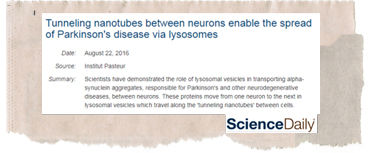HYPE?
Media portrayal:

HOPE?
Scientific interpretation:
Cellular “trash collectors” may help Parkinson’s disease spread in the brain
Original article: Tunneling nanotubes spread fibrillary a-synuclein by intercellular trafficking of lysosomes. EMBO J: Aug 22, 2016
The takeaway
Alpha-synuclein, a protein that plays an important role in Parkinson’s disease, hijacks normal cellular transport to travel from cell to cell.
Why is it important?
The spread of abnormal alpha-synuclein is the mechanism by which Parkinson’s disease progresses. A better understanding of how this occurs gives scientists a potential new target for developing therapies that slow or stop the disease in its tracks.
Impact
“This is an intriguing, novel mechanism whereby a Parkinson’s disease associated-protein might spread from one cell to another in the brain.” Dr. Patrik Brundin
%
IMPACT
- Novelty 80%
- Proximity 20%
- Deliverability 20%
Background
Much like sticky grains of rice, abnormal alpha-synuclein clumps together, forming the Lewy bodies found in the brains and nervous systems of people with Parkinson’s. It is thought that cells’ inability to clean out these proteins causes inflammation and, ultimately, damage or death to the cell. When enough of the dopamine-producing cells in the brain are damaged or killed, Parkinson’s hallmark movement problems begin.
The details
Although scientists have known for a while that the spread of alpha-synuclein leads to Parkinson’s disease progression, they didn’t know exactly how this happens. Using cellular models of Parkinson’s (viewed using a microscope). The new study shows that alpha-synuclein hijacks the cell’s own trash removal and transport systems to move between cells.
Here’s how it works:
- The cell recognizes alpha-synuclein fibrils (thin, wire-like extensions of the protein) as problematic and targets them for removal
- The cell sends lysosomes, which can be thought of as the cell’s trash collectors, to envelope the alpha-synuclein.
- The alpha-synuclein fibrils, in turn, promote the creation of “tunneling nanotubes,” between the affected cell and other nearby cells. Think of it like a subway tunnel connecting two stops.
Much like subway cars full of passengers, lysosomes packed with alpha-synuclein fibrils travel down the tubes and into a new cell.
Related work
Research in this area is ongoing, two recent review articles have discussed the current evidence how alpha-synuclein might spread from cell-to-cell in Parkinson’s and have highlighted this role of lysosomes and tunneling nanotubes.
Where can I learn more?
Original article: Abounit S, Bousset L, Loria F, Zhu S, de Chaumont F, Pieri L, Olivo-Marin JC, Melki R, Zurzolo C. Aug 22, 2016. Tunneling nanotubes spread fibrillary a-synuclein by intercellular trafficking of lysosomes. EMBO J:e201593411.



